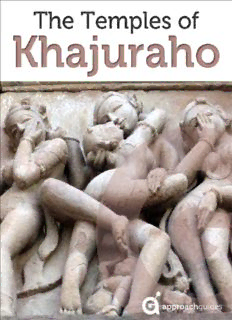
India Revealed: The Temples of Khajuraho PDF
Preview India Revealed: The Temples of Khajuraho
Guide to the Temples of Khajuraho (India) Version 1.2 by David Raezer and Jennifer Raezer © 2015 by Approach Guides All rights reserved. No part of this book may be reproduced in any form or by any electronic or mechanical means, without permission in writing from the publisher (excluding Creative Commons images). Further, this book is licensed for your personal enjoyment only and may not be resold or given away to other people. Copyright, licensing and attribution information can be found in the metadata for all images and illustrations. Approach Guides and the Approach Guides logo are trademarks of Approach Guides LLC. Other marks are the property of their respective owners. Although every effort was made to ensure that the information was as accurate as possible, we accept no responsibility for any loss, damage, injury or inconvenience sustained by anyone using this guidebook. Approach Guides New York, NY www.approachguides.com ISBN: 978-1-936614-24-0 Contents Introduction Basics of Hindu Architecture History of Indian Temple Building Understanding a Hindu Temple Architecture Decoration North and South Indian Temples Compared North Indian (Nagara) Temple Style South Indian (Dravidian) Temple Style Khajuraho’s Temples Background Pinnacle of North Indian Temple Style Reliefs and Sculptures Style and Types Erotic Reliefs – History and Meaning Tour of Western Group Temples 1. Lakshmana 2. Vishvanatha 3. Chitragupta 4. Devi Jagadambi 5. Kandariya Mahadeva Featured Southern Group Temple: Chaturbhuj TRAVEL TIPS Continuing Travel in India India Reading List Packing List ABOUT APPROACH GUIDES Join Our Email List! More from Approach Guides Introduction Previewing this book? Please check out our enhanced preview, which offers a deeper look at this guidebook. Travel guidebooks for the ultra curious, Approach Guides reveal a destination’s essence by exploring a compelling aspect of its cultural heritage: art, architecture, history, food or wine. The magnificent 10th-12th century Hindu temples of Khajuraho — with their soaring towers and engaging sculptures — represent the pinnacle of the North Indian temple style. Still infused with their historical magic, they are yours to discover. What’s in this guidebook Art and architecture review. We provide an overview of Hindu architecture, isolating trademark features that you will see again and again while touring Khajuraho’s temples. To make things come alive, we have packed our review with high-resolution images. The Khajuraho style. We then turn our focus to the temples of Khajuraho, highlighting the architectural advancements that were undertaken to make them the culmination of the North Indian temple style. To help travelers understand the groundbreaking nature of these advancements, we compare the temples of Khajuraho with those in the neighboring state of Orissa. Tour of the highlights. Following our tradition of being the most valuable resource for culture-focused travelers, we offer a tour of Khajuraho’s premier temples: Lakshmana, Vishvanatha, Chitragupta, Devi Jagadambi, and Kandariya Mahadeva. For each, we reveal its most important architectural and decorative features and offer a discussion that ties it all together. The reliefs. Since the inevitable highlight of any visit to Khajuraho is seeing the famous erotic reliefs that adorn its temples’ walls, we reveal their stylistic features, their symbolism, and the religious philosophy of Tantra that likely inspired them. Advice for getting the best cultural experience. To help you plan your visit, this guidebook supplies logistical advice, maps and links to online resources. Plus, we give our personal tips for getting the most from your experience while on location. Information the way you like it. As with all of our guides, this book is optimized for intuitive, quick navigation; information is organized into bullet points to make absorption easy; and images are marked up with text that explains important features. Contact us anytime Our readers are our greatest inspiration. Email us at [email protected] to let us know about your experience with Approach Guides — many of our recent updates have been inspired by customers like you. We personally respond to every email. We hope this cultural guidebook offers you fresh insights into Khajuraho’s Hindu temples and sets you on a path to making your own discoveries. Enjoy your trip! David and Jennifer Raezer Founders, Approach Guides www.approachguides.com Continuing Travel in India Are you continuing on to see the Islamic highlights of Delhi and Agra, the rock- cut caves of Ajanta, Ellora and Elephanta or the Hindu temples in south India? See our India guidebooks. Basics of Hindu Architecture History of Indian Temple Building The Hindu temples of Khajuraho are the culmination of an Indian architectural tradition that originated with Buddhist sanctuaries and monasteries carved into hillsides over 1000 years prior to their construction (see Fig. 1). This section provides an overview of the origins and development of the longstanding pre- Khajuraho temple building tradition. Buddhists Pioneer Stone Architecture in India Types of stone architecture There are two types of stone architecture: Rock cut. Rock-cut architecture is made by carving into natural rock. Usually hewn into the sides of mountain ridges, rock-cut structures are made by excavating rock until the desired forms are achieved. Stone built. The focus of this guidebook, stone-built architecture, on the other hand, involves assembling cut stone pieces to form a whole. Fig. 1. Timeline of stone architecture in India. Buddhism gets the ball rolling The first stone architecture in India was rock cut and executed by Buddhist monks; prior to these structures, all architecture had been made of wood. The most impressive examples were rock-cut religious sanctuaries, excavated directly out of the basalt mountains lining the western edge of the Deccan Plateau, the elevated, v-shaped landmass that comprises most of the Indian peninsula. The caves at Ajanta — as well as those at nearby Bedsa, Bhaja, Karla, Kondane, Nashik, and Pitalkhora — were part of this initial wave of excavations. Inspiration for India’s rock-cut architecture Early Buddhist architecture was likely indirectly inspired by that of the Egyptians. The Egyptians were probably the first civilization in
Description: